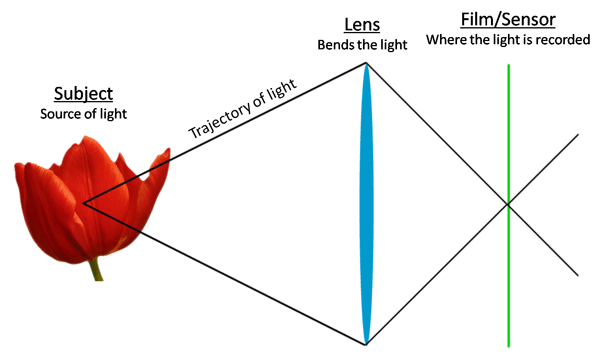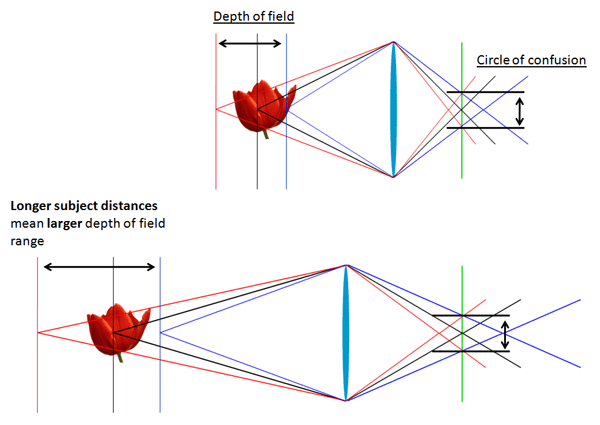Assignment, Week 12: Depth of field
Theme of the week: "Life-sized"
Whenever you take a photograph, you need to "focus" the camera. That's the difference between a good picture with correct focus like this:
And a ruined picture with incorrect focus like this:
Here's a simple diagram of camera's basic elements - the lens and the sensor. The lens works to bend the light that it receives and project it onto the sensor, which then measures the light. If this is all operating correctly, the light from the subject will re-converge at the same location on the sensor, and our picture is sharp and "in focus".

If the lens/sensor/subject are oriented in a way so that the light doesn't converge, however, we get a picture that isn't in focus. The amount of "out of focus" blur is determined by how far off the trajectory is from converging. Here you can see that the image will be very badly misfocused, since the top red trajectory and bottom red trajectory don't come close to converging.

The image trajectories don't have to perfectly converge. There is a tolerable range known as the "circle of confusion". As long as the trajectories still converge within this range, the image will still be sharp enough to be considered "in focus", even if it isn't perfect.

An interesting image attribute of photography and optical systems is that there is only ever one distance that is actually in perfect focus.

Notice here that at one point in the picture - where the "of" is, the picture is perfectly sharp and "in focus", as we'd expect. This is our focus distance. However, as we get further and further away from that point - farther away towards the word "Depth", or closer towards the word "Field", the images gets increasingly blurrier. At the closest and farthest ends, the detail becomes almost indistinguishable (notice how you can barely make out the cross-hatch pattern of lines?).
What's actually going on is that as you move away from the focus distance you've selected, the focus error (how much the rays of light fail to converge, per the diagrams above) increases, so the image gets blurrier and blurrier. There is only a certain range of distances which are actually "in focus", where you can make out discernable detail (what constitutes "in focus" and "out of focus" is defined by the 'circle of confusion' from above). This range is called the "depth of field".



Here's another of example demonstrating how depth of field can effect a picture. I chose the focus distance to focus on the main subject in the center. As a result, the girl on the left, who is at almost the same distance, is also focused and sharp. However the guy on the right, who is much closer to the camera and has a shorter distance, is out of focus and blurry. Similarly the chairs in the back are much farther away and are similarly out of focus.

There are three factors that are going to determine the size of this depth of field: aperture, focus distance, and focal length.
By making the aperture (size) of the lens bigger, the angle at which the light is coming in and the angle at which light is being bent is made much steeper. As a result, the trajectories of light fail to converge even more, andthe depth of field range is made smaller. For example, if you went from an f/5.6->f/2.8 aperture, the depth of field range would shrink, and vice versa.

Another attribute that can change is the distance of the subject, or the distance that you're focusing at. Again, this changes the angle at which light comes in - with longer distances you have less steep angles, and correspondingly the light converges closer, giving you more depth of field. Instead of standing right up to your subject and using a very close focus distance, for example, you can stand further away and use a longer focus distance, giving you a larger depth of field range.

The third attribute is the focal length of the lens. Focal length is an attribute of the glass itself - the numbers themselves have no real meaning, but with longer focal length lenses the light is bent less sharply, and thus depth of field will be greater. In pragmatic terms, we utilize longer focal lengths when we have a narrow angle of view, or when we "zoom in", so by zooming in we get a smaller depth of field range. In this example, the lens on the bottom has a longer focal length.

The actual formula for depth of field is this ugly mess:

- N is the aperture f-stop number, so 5.6 for f/5.6, for example. Smaller number means bigger lens.
- c is the diameter of the circle of confusion. This is somewhat arbitrarily defined, so ignore this for the most part.
- f is the focal length of the lens. This is labeled on most camera's lenses, or you can find this after the fact by looking at the image properties.
- s is the focus distance - how far away from you the subject is.
| Small depth of field | Large depth of field |
| Large aperture (small f-number) | Small aperture (large f-number |
| Close focus distance (very close to subject) | Long focus distance (far away from subject) |
| Long focal length (telephoto, "zoomed in") | Short focal length (wide angle, "zoomed out") |
Now, which do we want - a large depth of field that gets more things in focus, or a small depth of field where only some things are in focus? The answer is pretty subjective, but there are some general uses depending on the type of photography.
Generally, things where you want a large depth of field are scenes like landscapes, or architecture, or macro. Here, you want everything to be sharp and in focus, so you want to shoot at smaller apertures to get a large depth of field (you can also use wide-angle and be further away from the subject, but these dramatically change other elements of your image).
Landscapes

Architecture with large depth of field

Architecture with small depth of field - with small depth of field you don't get to see any details in the building

Macro with large depth of field

Macro with small depth of field - we don't get to see all the details in the image

However, shallow depth of field can have its uses too. Oftentimes, using a shallow depth of field helps us isolate a single subject, since everything else (distracting background, other image elements) will be blurred out.
Portraits

Flowers

Sports

Basically, any kind of photo where we want to isolate and concentrate on a single subject

For this week's assignment, we'll be experimenting with very small depth of field. Using the three parameters (aperture, focus distance, focal length), attempt to take pictures with a very small depth of field. Note that for most consumer cameras, this is very difficult because the focal lengths on their lenses are very very small - you'll have to push things like aperture and subject distance to the extreme to get a shallow depth of field (try macros).
There is a downside to all this small depth of field, however - it makes focusing errors much more prominent. Going back to an earlier photo, notice how this image is somewhat ruined because I used a very small depth of field that only has correct focus on one subject. I should have used a larger depth of field to make sure the person in front was also sharp, instead of becoming a blurry blob like in this image.

Assignment Summary:
- Take photos with a very small depth of field.
- Utilize aperture, focal length, and subject/focus distance to control depth of field.
- For most consumer cameras, depth of field will be very large regardless because of the short focal length. You'll need to do some extreme things with the other factors (think macro - activate the 'flower' button or setting and focus up-close).
Resources:
- Knowing depth of field numbers are not particularly useful, but if you're so inclined you can use a depth of field calulator.
